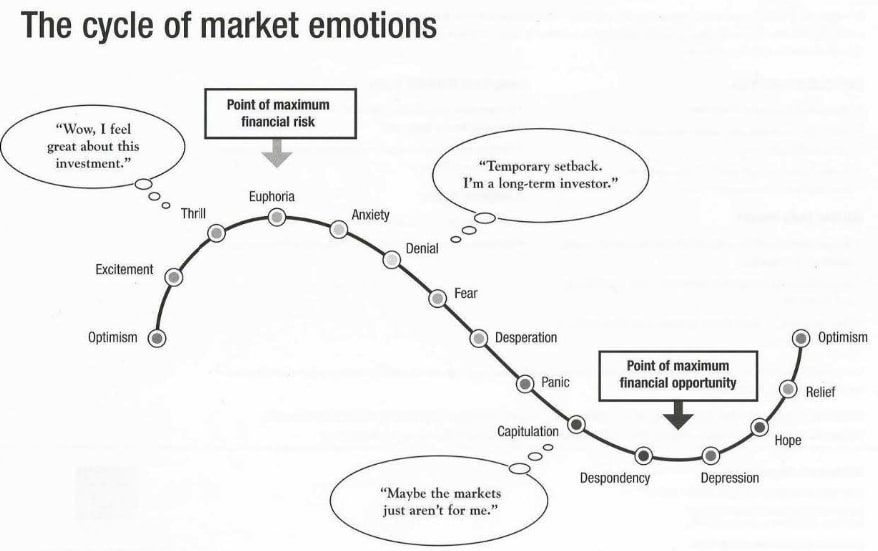The term ‘bull market’ is used to describe a rising stock market. When the prices of shares are gradually increasing, the overall sentiments among investors is positive – which leads to more people entering the market.
‘Bull Market’ is exactly the opposite of a ‘Bear Market’ – where investors experience fear and sell their shares at low prices, whereas in ‘Bull Market’ investors buy out of greed and don’t mind paying high prices.
A ‘Bull Market’ typically begins at the end of a ‘Bear Market’, when sentiments are low and most inexperienced investors have already sold their holdings and left the market.
Interest to invest in the stock market will be low. There will be a flow of negative news ranging from chances of prolonged recession, tough economic conditions, company layoffs, unemployment, falling GDP rate etc.
It’s at this time that valuations are low and smart investors accumulate shares at low prices. Most individual investors would be too scared to buy anything at this point – due to gloomy forecasts for the immediate future. The general belief and fear is, market will fall further.
When the markets actually ‘bottoms out’ and begins its first up-move, most investors prefer staying out of the market. This is because the rise is expected to lead to another fall – something that investors would’ve got accustomed to during the ‘bear market’.
The rise usually continues steadily and before investors realise, most stocks would be up 20-30% from their lows. Eventually, most of those who were waiting for the market bottom to invest – would be reduced to mere spectators – as the market would continue its march ahead.
It’s only after the market has significantly risen from its lows – when suddenly there would be more positive news on business channels, the GDP numbers would have improved and the future wouldn’t look as gloomy as it did just a few months ago.
These are typical traits of a bull market – even though every market cycle (bear and bull / up and down cycle) can be different from the other.
The last stage of the bull market – when the market actually tops out – can leave investors in a state of awe and euphoria. Stock market would be the topic of discussion everywhere, between friends, at get togethers etc.
At this point, most stocks would be rising to insanely high valuations, even low-quality companies would be showing big gains. Even investors who have newly entered the market – would begin to consider themselves as investment gurus as most of their investments would be rising.
The stock recommendations on business channels would’ve moved from high-quality large caps in a bear market, to low-quality small caps at the peak of bull market.
These are usually the first signs of an impending fall in the market. It’s at this stage that experienced and big investors begin to cash-out and sell their holdings. New investors, who bought bad companies at high prices, get trapped and the market begins its journey downwards.

The above image illustrates the cycle of the market. When the market is on the rise, there is optimism. Soon, that changes into excitement and thrill – it’s at this stage that many new investors get lured by rising market. They want to try their luck and think making money in the stock market is easy.
The market continues to rise to insane levels. This attracts even more new and inexperienced investors.
They enter the market with very little knowledge and buy shares of companies that are doing well. Since the peak of the bull market has low-quality companies rising the highest, this is where most of the new-investor money goes.
That’s when the market begins to turn downwards. When the fall is 10%, most new investors are in denial – they turn long-term investors thinking the fall is temporary and the market will rise again.
A fall of 10% more is the bear phase of ‘fear’ where everyone is spreading negative news about the market, the state of the economy etc.
Another 10% fall leads to ‘desperation’ among investors – that they somehow want to atleast recover the amount they invested. At this point, the market inflicts more pain by falling more, which leads to ‘panic’. It is during these times that most new investors have their portfolio down by 50-60%. Now, they just want to save whatever money is left, they sell out.
This last phase of the bear market can be brutal, as most investors sell out of panic. It’s after this phase that the market will move sideways, consolidate, remove all the weak hands. Low-quality stocks or fraud companies that moved the most during the last phase of the bull market – will become penny stocks, they won’t rise back in the next cycle of the market.
Quality companies will show signs of recovery and will be the first to move up. This is usually one of the first signs of recovery towards hope, relief, optimism and finally another bull market.
The market cycle continues.

Leave a Comment